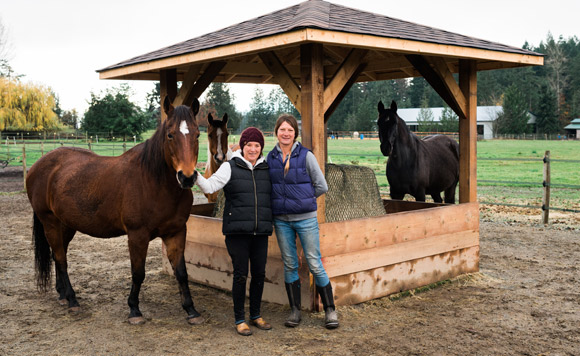by Cassidy Nunn –
Nestled off Downey Road in North Saanich, down a lovely long driveway bordered by massive green pasture, you’ll find the horse boarding facility Downey Farm. The 20.3-acre property has been lovingly owned and operated by Iris and Mark Benson for the past 26 years, and although horses came into their lives after they purchased the acreage, (at first it was home to sheep) horses have now become the centre of all they do on their farm.
I recently met with Iris (above left) and her barn manager, Ann Martins (above right), on a chilly fall day for a tour of the expansive facility and to learn about how their boarding “style” is working to bring horse boarding back to a more natural way of living. “We’re here for the horses,” says Iris, and “looking to stand up for the horses’ needs,” adds Ann, who has a long history of working with horses and has managed Downey Farm for the past three years. Iris and Ann describe the barn as a “non-competitve environment” where they strive to create a lifestyle and environment for the horses that is in tune as much as possible with their natural needs.
Twenty years ago, Mark bought Iris her first horse, Ruby, who is enjoying her retirement on the farm, and from there through word of mouth, they began to take in client boarding horses. Over the years they continued to expand the facility to keep up with the growing demand. They now offer indoor and outdoor arenas, round pen, chip trails, mountain trail obstacles, and room for 27 horses.
I noticed when driving in, the sheer amount of turnout space for the horses and that many of the horses were living in small herds or paired up. Pastures are hard to come by here on the Peninsula – there’s simply not a lot of land – and many horse boarding facilities don’t have enough extra land to dedicate to pasture and allow for year-round grazing. Our climate also doesn’t help matters: as soon as the winter rainfalls begin, the pastures often become too soggy and the horses will tear the ground up with their feet, churning the field into mud. At Downey, they’ve separated the pastures to allow for smaller, winter pastures and larger summer pastures which are left closed throughout the winter to allow the grass to regenerate.
When there’s not enough space, it’s also difficult to allow horses to live with each other in herds or groupings, which is a more natural way of living for them as they’re social animals who live in herds in the wild. At Downey, Ann works to integrate the horses into mini herds of three to seven (as long as the horse’s owners consent to this) or to find a “buddy” to pair horses up with during the day so that they can have the benefits of socialization as a part of their routine.
Slow feeder hay nets are used to allow the horses access to forage 24/7. These hay nets have very small holes that slow the horses down when eating, so that they can only get small nibbles of hay at a time. This is a more natural way of eating for horses as in the wild they graze on grass, eating tiny mouthfuls, for close to 20 hours a day. The hay nets are hung low to the ground to encourage the horses to eat in a more natural position with their necks long and their heads down, again to emulate natural grazing.
Much of the setup at Downey Farm is designed to encourage the horses to keep moving as well as to make it easier for their owners to keep their horses moving, whether it’s in the riding arenas, walking along the expansive chip pathway, or having the access to pasture. Many of the boarders are long term and a number are older horses who benefit greatly from plenty of slow moving.
Downey Farm is at maximum capacity at the moment and a wait list is being taken for anyone looking for horse or pony board. Apart from boarding, in the spring and summer children’s horsemanship classes are also offered at Downey Farm so stay tuned for more information on the upcoming 2020 classes.




